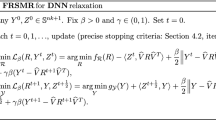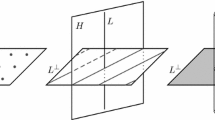Abstract
We present an analytic center cutting surface algorithm that uses mixed linear and multiple second-order cone cuts. Theoretical issues and applications of this technique are discussed. From the theoretical viewpoint, we derive two complexity results. We show that an approximate analytic center can be recovered after simultaneously adding p second-order cone cuts in O(plog (p+1)) Newton steps, and that the overall algorithm is polynomial. From the application viewpoint, we implement our algorithm on mixed linear-quadratic-semidefinite programming problems with bounded feasible region and report some computational results on randomly generated fully dense problems. We compare our CPU time with that of SDPLR, SDPT3, and SeDuMi and show that our algorithm outperforms these software packages on problems with fully dense coefficient matrices. We also show the performance of our algorithm on semidefinite relaxations of the maxcut and Lovasz theta problems.
Similar content being viewed by others
References
Alizadeh, F., Goldfarb, D.: Second-order cone programming. Math. Program. 95(1), 3–51 (2003)
Atkinson, D.S., Vaidya, P.M.: A cutting plane algorithm that uses analytic centers. Math. Program. Ser. B 69, 1–43 (1995)
Basescu, V.L., Mitchell, J.E.: An analytic center cutting plane approach for conic programming. Rensselaer Polytechnic Institute, Troy, NY 12180 (June 2005)
Borchers, B.: SDPLIB 1.2, a library of semidefinite programming problems. Optim. Methods Softw. 11, 613–623 (1999)
Burer, S., Choi, C.: Computational enhancements in low-rank semidefinite programming. Optim. Methods Softw. 21(3), 493–512 (2006)
Burer, S., Monteiro, R.D.C.: A nonlinear programming algorithm for solving semidefinite programs via low-rank factorization. Math. Program. Ser. B 95(2), 329–357 (2003)
Burer, S., Monteiro, R.D.C.: Local minima and convergence in low-rank semidefinite programming. Math. Program. Ser. A 103(3), 427–444 (2005)
Chua, S.K., Toh, K.C., Zhao, G.Y.: An analytic center cutting plane method with deep cuts for semidefinite feasibility problems. J. Optim. Theory Appl. 123, 291–318 (2004)
Goffin, J.-L., Vial, J.-P.: Multiple cuts in the analytic center cutting plane methods. SIAM J. Optim. 11, 266–288 (2000)
Goffin, J.-L., Luo, Z.-Q., Ye, Y.: Complexity analysis of an interior cutting plane for convex feasibility problems. SIAM J. Optim. 6, 638–652 (1996)
Helmberg, C.: Semidefinite programming for combinatorial optimization. Habilitationsschrift, ZIB-Report 00-34 (October 2000)
Helmberg, C.: Numerical evaluation of SB method. Math. Program. 95, 381–406 (2003)
Helmberg, C., Rendl, F.: A spectral bundle method for semidefinite programming. SIAM J. Optim. 10(3), 673–696 (2000)
Kim, S., Kojima, M., Yamashita, M.: Second order cone programming relaxation of a positive semidefinite constraint. Optim. Methods Softw. 18(5), 535–541 (2003)
Krishnan, K., Mitchell, J.E.: A unifying framework for several cutting plane methods for semidefinite programming. Optim. Methods Softw. 21(1), 57–74 (2006)
Krishnan, K., Mitchell, J.E.: A semidefinite programming based polyhedral cut-and-price approach for the maxcut problem. Comput. Optim. Appl. 33(1), 51–71 (2006)
Lewis, A.S., Overton, M.L.: Eigenvalue optimization, Acta Numer., 149–190 (1996)
Luo, Z.-Q., Sun, J.: An analytic center based on column generation algorithm for convex quadratic feasibility problems. SIAM J. Optim. 9(1), 217–235 (1998)
Luo, Z.-Q., Sun, J.: A polynomial cutting surfaces algorithm for the convex feasibility problem defined by self-concordant inequalities. Comput. Optim. Appl. 15, 167–191 (2000)
Lüthi, H.J., Büeler, B.: The analytic center quadratic cut method (ACQCM) for strongly monotone variational inequality problems. SIAM J. Optim. 10(2), 415–426 (2000)
Mitchell, J.E., Basescu, V.L.: Selective Gram-Schmidt orthonormalization for conic cutting surface algorithms. Technical report, Mathematical Sciences, Rensselaer Polytechnic Institute, Troy, NY 12180 (December 2006). Accepted for publication in Mathematical Methods of Operations Research
Mitchell, J.E., Todd, M.J.: Solving combinatorial optimization problems using Karmarkar’s algorithm. Math. Program. 56, 245–284 (1992)
Oskoorouchi, M.R., Goffin, J.L.: The analytic center cutting plane method with semidefinite cuts. SIAM J. Optim. 13(4), 1029–1053 (2003)
Oskoorouchi, M.R., Goffin, J.L.: An interior point cutting plane method for the convex feasibility problem with second-order cone inequalities. Math. Oper. Res. 30(1), 127–149 (2005)
Oskoorouchi, M.R., Goffin, J.L.: A matrix generation approach for eigenvalue optimization. Math. Program. Ser. A 109, 155–179 (2007)
Overton, M.L.: Large-scale optimization of eigenvalues. SIAM J. Optim. 2, 88–120 (1992)
Sharifi Mokhtarian, F., Goffin, J.-L.: An analytic center quadratic cut method for the convex quadratic feasibility problem. Math. Program. Ser. A 93(2), 305–325 (2002)
Sivaramakrishnan, K.: A parallel conic interior point decomposition approach for BLOCK-ANGULAR semidefinite programs. Technical Report, Department of Mathematics, North Carolina State University, Raleigh, NC, 27695 (December 2006)
Sivaramakrishnan, K., Plaza, G., Terlaky, T.: A conic interior point decomposition approach for large scale semidefinite programming. Technical Report, Department of Mathematics, North Carolina State University, Raleigh, NC, 27695 (December 2005)
Sonnevend, G.: New algorithms in convex programming based on a notation of center and on rational extrapolations. Int. Ser. Numer. Math. 84, 311–327 (1988)
Sturm, J.F.: Using SeDuMi 1.02, a MATLAB toolbox for optimization over symmetric cones. Optim. Methods Softw. 11–12, 625–653 (1999)
Sturm, J.F.: Implementation of interior point methods for mixed semidefinite and second order cone optimization problems. Optim. Methods Softw. 17(6), 1105–1154 (2002)
Sun, J., Toh, K.C., Zhao, G.Y.: An analytic center cutting plane method for semidefinite feasibility problems. Math. Oper. Res. 27(2), 332–346 (2002)
Toh, K.C., Todd, M.J., Tutuncu, R.H.: SDPT3—a Matlab software package for semidefinite programming, version 2.1. Optim. Methods Softw. 11, 545–581 (1999)
Toh, K.C., Zhao, G.Y., Sun, J.: A multiple-cut analytic center cutting plane method for semidefinite feasibility problems. SIAM J. Optim. 12(4), 1126–1146 (2002)
Tutuncu, R.H., Toh, K.C., Todd, M.J.: Solving semidefinite-quadratic-linear programs using SDPT3. Math. Program. Ser. B 95, 189–217 (2003)
Ye, Y.: A potential reduction algorithm allowing column generation. SIAM J. Optim. 2, 7–20 (1992)
Ye, Y.: Complexity analysis of the analytic center cutting plane method that uses multiple cuts. Math. Program. 78, 85–104 (1997)
Author information
Authors and Affiliations
Corresponding author
Additional information
M.R. Oskoorouchi’s work has been completed with the support of the partial research grant from the College of Business Administration, California State University San Marcos, and the University Professional Development Grant.
J.E. Mitchell’s material is based upon work supported by the National Science Foundation under Grant No. 0317323. Any opinions, findings, and conclusions or recommendations expressed in this material are those of the author(s) and do not necessarily reflect the views of the National Science Foundation.
Rights and permissions
About this article
Cite this article
Oskoorouchi, M.R., Mitchell, J.E. A second-order cone cutting surface method: complexity and application. Comput Optim Appl 43, 379–409 (2009). https://doi.org/10.1007/s10589-007-9141-x
Received:
Revised:
Published:
Issue Date:
DOI: https://doi.org/10.1007/s10589-007-9141-x




